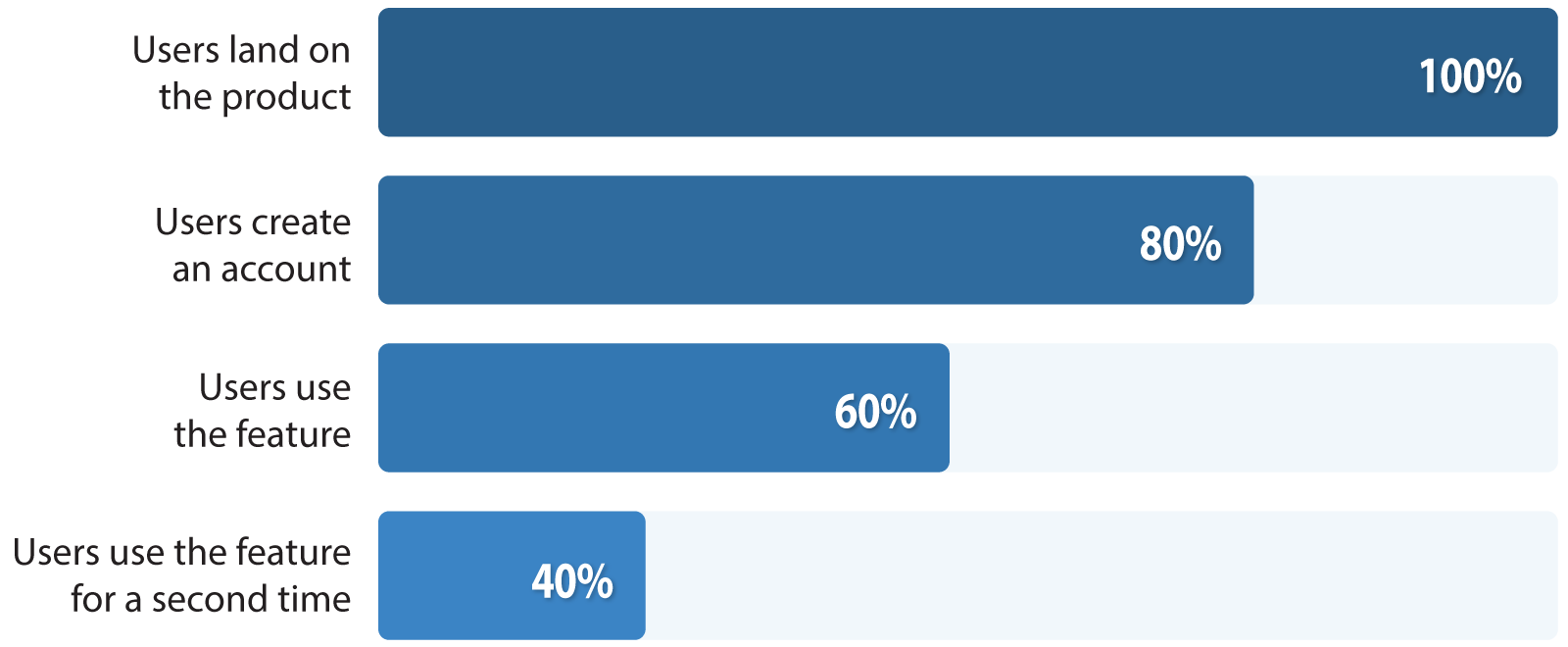Adoption Metrics: Tutorial & Examples
Competition across software vendors drives innovation, resulting in the development of new features and constant tuning of existing ones. Adoption metrics provide insights into how users react to new products and features, giving production teams a sense of whether their efforts are as successful as intended.
Product adoption is achieved when users incorporate a product or feature into their regular usage. This article will explain the various ways that users might adopt a product or feature, which metrics are most important when optimizing for adoption and typical challenges of measuring adoption success.
Measuring product adoption correctly
Product adoption metrics measure how users derive value from your product. When measuring adoption, companies typically struggle to define “aha moments,” user journeys, and success criteria. Features can make or break software products, but not all features deliver similar value and oftentimes it’s tough to pick and choose the ones that match your business, user, and product goals.
“Aha moments” occur when users discover the value of core features for the first time. Users adopt those features when they integrate them into regular usage. Depending on the product, regular usage can be defined as daily, weekly or even monthly use of a product or feature.
It’s good practice to draw early consensus on what the core features are and what expected adoption could be. A good strategy could save substantial effort in the implementation phase and helps teams stay aligned when tracking and measuring success.
Selecting relevant adoption metrics requires a well tuned analytics strategy. In executing one, we must consider a product’s core features, map them onto a user journey and measure their usage via analytics tools like Gainsight PX. This technique should be considered for new and existing features, since either can drive “aha moments” for newly acquired users. The task of defining adoption for any product or feature can be broken down into three primary components:
Defining key features, “aha moments” and usage frequency
First, define which features provide core value to the user. Next, decide at what point might the user reach a measurable “aha moment.” This can usually be defined as an action or a set of actions that a user must take before they recognize the value of your product or feature. Since adoption is achieved when a user incorporates the product or feature into their workflow, the final step is to define a usage frequency and timespan over which the frequency must be achieved for the feature to be considered “adopted”.
Healthy usage frequencies vary dramatically from one product to another. Consumer products may be considered healthy if used multiple times a day. Users of business focused products may engage daily or weekly. Other products may drive usage monthly, seasonally or even situationally, like in the case of a marketplace or job board. Here are some examples of various products, measurable “aha moments” and possible healthy usage frequencies:
| Product | “Aha moment” | Frequency |
|---|---|---|
| Meditation app | User completes a meditation session | Twice a week for one month |
| Team workflow tool | User creates a new task and assigns it to a team member | Three times a week for a quarter |
| Business intelligence tool | User checks the company sales dashboard | Twice a week for two months |
| Educational app | User completes a lesson | Once every four days |
| Banking app | User deposits a check | Monthly for one quarter |
Measuring product adoption
With this strategy in mind, here are some metrics commonly used to define adoption. Note that a user base is typically divided into cohort groups, delineated by a segmentation strategy. Metrics can often provide more insight when parameters are limited to a single cohort, as opposed to the entire user base.
- Adoption rate: The percentage of users who experience a feature´s value and integrate it into their workflow.
- Activation rate: The percentage of users who experience value from a feature (“aha moment”) for the first time.
- Stickiness ratio: The average frequency at which users return. This ratio is calculated by dividing the DAU (number of daily active users) by the MAU (number of monthly active users).
- User session length: The average time a customer uses the product in a single session. Especially valuable for measuring the quality of content in products such as blogs, videos, music, and podcasts.
- Breadth of adoption: Sometimes, a product’s core value is realized via adoption of multiple features. Calculating how many features have been adopted gives us another perspective.
- Time to value: the time between a user’s initial access of a product or feature and the moment they realize value. Progress is usually achieved by decreasing this metric over time.
- User flow: a map of behaviors leading to “aha moments”, as well as, actions that users take after realizing value.
Phases of adoption
Adoption can be broken down into several phases. Let’s take a closer look at what they are and how they fit into the user’s journey.
- Users activate the feature by using it for the first time
- Users adopt the feature by using it again with the expected frequency over a defined period of time
- Users adopt more complex parameters of the initial feature, ultimately deriving more long-term value from the product
Here’s an example of how these phases may be defined for a team communications product:
- User adds their team to the product and writes a post
- Other users begin to engage with the post, “liking” it or writing responses
- User installs an integration with a 3rd-party content application and writes another post leveraging this content, drawing more engagement from the group
With this framework, we can track adoption by looking at varying paths users take on the way to an “aha moment,” as well as, what happens afterwards. This path is known as a user journey and can be distilled into the following steps:

This image shows how adoption fits into the context of a user’s journey
|
Platform
|
Out-of-the-Box KPIs
|
Segmentation
|
Feature-Level Adoption & Retention Analysis
|
Cross-Channel User Engagements
|
Engagement Impact Analysis
|
A.I-Powered Product Feature Mapping
|
Mobile Application Support
|
|---|---|---|---|---|---|---|---|
|
Gainsight
|
✔
|
✔
|
✔
|
✔
|
✔
|
✔
|
✔
|
|
Heap
|
✔
|
✔
|
✔
|
✔
|
|||
|
Pendo
|
✔
|
✔
|
Taking action with data
A proper analytics strategy starts with a platform that allows granular collection of usage data. For this step, it’s crucial to work closely with your development team to ensure that features and actions in your product are tagged in a way that will yield correct data. Once your analytics strategy is implemented, it’s time to tune your product to achieve better results. Here are some actions you can take to drive better adoption metrics:.
Improving adoption rate
Improving this metric is essential and probably the most difficult to achieve, as you must consider multiple factors. Here are some suggestions:
Create a funnel to measure success
Sometimes it takes a user several steps to arrive at a feature. We can measure how effective the product is at guiding users to “aha moments” with a funnel. A product that is unnecessarily complex may add dreaded user friction to a typical flow, decreasing the percentage of users moving from one step of the funnel to the next. Check your activation and adoption funnels on a regular basis, simplify the UX and address all bugs or issues to improve the overall experience. Here’s an example of an activation/adoption funnel:

This image shows a sample adoption funnel
Success criteria
Determine whether your chosen success criteria are realistic with respect to usage or user expectations. Interview your users early and often to understand their perspective. Survey your users for a quantitative perspective.
Choose your target audience wisely
Sometimes, low adoption is the result of a mismatch between the audience’s expectations and the product’s value proposition. Shifting your target audience may enable you to optimize acquisition performance and adoption rates by eliminating low performing users.
Improving activation
Activation and adoption are usually treated as different metrics, but activation can also be measured as a subset of adoption. Here are some recommended steps for improving activation:
- Use in-app messages to reinforce a feature’s value if they drop out of the funnel prior to reaching activation.
- Use an in-app checklist of actions that leads users towards an activation.
- Use a segmentation strategy to separate your users into cohorts. Improve lower performing cohorts by understanding what makes better performing cohorts more successful.
- Improve your product’s user experience through good design. Reduce friction and simplify where possible.
Improving time-to-value
Time-to-value is the measure of how long it takes a user to realize a product´s value. It’s typically tracked as steps in a funnel that begins with the user’s first interaction with the product and ends once they’ve reached the defined “aha moment”. To improve time-to-value:
- Check user flows to understand where users are dropping-off and investigate why this is happening.
- Remove as much friction as possible from each step in the funnel.
- Optimize the onboarding process and ensure that users are encouraged to advance by reminding them of the value proposition.
How various stakeholders use adoption metrics
Many different organizations within a company can benefit from tracking adoption metrics.
Product Managers use adoption metrics to improve the user experience by removing friction and shortening the path to value realization. Understanding user preferences and activation levels allows PMs to set realistic goals and introduce new strategies while maintaining focus on delivering value.
Customer Support teams can better understand their users’ challenges and create effective mitigation strategies. This can include proper messaging, support articles, and user feedback loops. A properly implemented support experience improves product awareness and education, often leading to better activation and adoption.
Product Marketers can use adoption metrics to gain a better understanding of their audience. Doing so enables them to tune messaging, experiment with different value propositions and refine target groups based on cohort performance.
Company executives gain a clearer understanding of how well a value proposition resonates with a market segment. They can use this information to drive product strategy, influence business goals, investments, roadmaps, and other aspects of the planning process.
Conclusion
Adoption metrics are critical to understanding a user’s initial experience and journey with a product. A proper implementation of adoption metrics can mean the difference between a product or feature’s success or failure. Understanding the various steps of user adoption can yield valuable insights into a product’s value and how that value is realized by its users. A product’s success depends critically on achieving product-market fit and improving adoption metrics is a primary factor towards achieving this goal. With this in mind, adoption metrics may just be the most important set of metrics driving your features, products and company.



